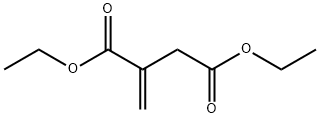Itaconic anhydride
Synonym(s):2-Methylenesuccinic anhydride;Itaconic anhydride
- CAS NO.:2170-03-8
- Empirical Formula: C5H4O3
- Molecular Weight: 112.08
- MDL number: MFCD00005530
- EINECS: 218-518-2
- SAFETY DATA SHEET (SDS)
- Update Date: 2025-07-04 15:20:35

What is Itaconic anhydride?
Chemical properties
WHITE TO CREAM CRYSTALLINE POWDER
The Uses of Itaconic anhydride
Itaconic anhydride is used in immobilization of β-glucosidase. It undergoes estrification to obtain suitable monomers for emulsion polymerization itaconates.
Preparation
To a flask equipped with a 12 mm diameter ground glass adaptor tube bent for downward distillation and joined to a 100 cm condenser is added 200 gm (0.95 mole) of citric acid monohydrate. An ice-cooled flask and a cold trap are connected to the condenser. The flask containing the citric acid is heated rapidly with a wide flame of the Meker burner so that in 12-15 min the distillation at 175-190°C is complete. The distillation is stopped earlier if the vapors in the reaction flask become yellow. Superheating of the citric acid will cause rearrangement to citraconic anhydride. The water is quickly separated from the distillate and the itaconic anhydride layer dried to afford 40-50 gm (37-47%), m.p. 67-68°C. Long time contact of the water with the anhydride causes it to hydrolyze to itaconic acid, m.p. 162-165°C.

Synthesis Reference(s)
Tetrahedron Letters, 25, p. 6027, 1984 DOI: 10.1016/S0040-4039(01)81751-2
General Description
Itaconic anhydride (ITA) is a biobased material that is obtained from renewable resources. It is produced from the pyrolysis of citric acid or by fermenting carbohydrates which forms itanoic acid. Itanoic acid can be dehydrated to form an anhydride. It is relatively more reactive that maleic anhydride and can be used as an alternating monomer that facilitates the introduction of polar functionalities in polymers.
Purification Methods
Crystallise the anhydride from CHCl3/pet ether. It can be distilled under reduced pressure. Distillation at atmospheric pressure, or prolonged distillation causes rearrangement to citraconic anhydride (2-methylmaleic anhydride). If the material (as seen in the IR spectrum) contains much free acid, then heat with acetyl chloride or SOCl2, evaporate and distil at as high a vacuum as possible. The crude anhydride deposits crystals of itaconic acid on standing probably due to hydrolysis by H2O — store it in sealed ampoules under dry N2. [Skinner et al. Org Synth Coll Vol II 368 1943, IR: Nagai Bull Chem Soc Jpn 37 369 1964, Kelly & Segura J Am Chem Soc 56 2497 1934, Beilstein 17/11 V 66.]
Properties of Itaconic anhydride
| Melting point: | 66-68 °C (lit.) |
| Boiling point: | 114-115 °C/12 mmHg (lit.) |
| Density | 1.2600 |
| refractive index | 1.5130 (estimate) |
| Flash point: | 114-115°C/12mm |
| storage temp. | Store below +30°C. |
| form | Crystalline Powder |
| color | White to cream |
| Water Solubility | Hydrolyzes in water. |
| Sensitive | Moisture Sensitive |
| BRN | 2212 |
| CAS DataBase Reference | 2170-03-8(CAS DataBase Reference) |
| NIST Chemistry Reference | 2,5-Furandione, dihydro-3-methylene-(2170-03-8) |
| EPA Substance Registry System | 2,5-Furandione, dihydro-3-methylene- (2170-03-8) |
Safety information for Itaconic anhydride
| Signal word | Warning |
| Pictogram(s) |
 Exclamation Mark Irritant GHS07 |
| GHS Hazard Statements |
H315:Skin corrosion/irritation H319:Serious eye damage/eye irritation H335:Specific target organ toxicity, single exposure;Respiratory tract irritation |
| Precautionary Statement Codes |
P261:Avoid breathing dust/fume/gas/mist/vapours/spray. P264:Wash hands thoroughly after handling. P264:Wash skin thouroughly after handling. P271:Use only outdoors or in a well-ventilated area. P280:Wear protective gloves/protective clothing/eye protection/face protection. P302+P352:IF ON SKIN: wash with plenty of soap and water. P305+P351+P338:IF IN EYES: Rinse cautiously with water for several minutes. Remove contact lenses, if present and easy to do. Continuerinsing. |
Computed Descriptors for Itaconic anhydride
New Products
Indole Methyl Resin tert-butyl 9-methoxy-3-azaspiro[5.5]undecane-3-carboxylate Boc-His(Boc)-OH 2-CTC Resin 4-Chloro-7-tosy1-7Hpyrrolo[2,3-d]pyrimidine 5,7-Dibromo-1H-indole 2,5-dichloro-N-hydroxy-4,6-dimethylpyridine-3-carboximidamide 2,2-Dimethoxy-7-azaspiro[3.5]nonane hydrochloride 4-chloromethyl-5-methyl-1,3-dioxol-2-one (DMDO-Cl) R-2-BENZYLOXY PROPIONIC ACID 1,1’-CARBONYLDIIMIDAZOLE 1,1’-CARBONYLDI (1,2-4 TRIAZOLE) N-METHYL INDAZOLE-3-CARBOXYLIC ACID 4-((2-hydroxyethyl)thio)benzoic acid 1-(TERT-BUTOXYCARBONYL)-2-PYRROLIDINONE Methyl 6-methylnicotinate 3-Pyridineacrylic acid tert-Butyl carbazate TETRAHYDRO-2H-PYRAN-3-OL 2-((4-morpholinophenylamino) (methylthio) methylene) malononitrile 3-(4-morpholinophenylamino)-5-amino-1H-pyrazole-4-carbonitrile 2,4-dihydroxybenzaldehyde 1,3-Diethyl-1,3-Diphenylurea Methyl 2-methylquinoline-6-carboxylateRelated products of tetrahydrofuran








You may like
-
 Itaconic anhydride 98% CAS 2170-03-8View Details
Itaconic anhydride 98% CAS 2170-03-8View Details
2170-03-8 -
 Itaconic anhydride >95% CASView Details
Itaconic anhydride >95% CASView Details -
 Itaconic Anhydride CAS 2170-03-8View Details
Itaconic Anhydride CAS 2170-03-8View Details
2170-03-8 -
 Itaconic anhydride CAS 2170-03-8View Details
Itaconic anhydride CAS 2170-03-8View Details
2170-03-8 -
 Pyridine 99.5% HPLC /UV SpectroscopyView Details
Pyridine 99.5% HPLC /UV SpectroscopyView Details
110-86-1 -
 Dibutyl PhthalateView Details
Dibutyl PhthalateView Details
84-74-2 -
 Imidazole Spot supply, competitive priceView Details
Imidazole Spot supply, competitive priceView Details
288-32-4 -
 Thiourea 99% ARView Details
Thiourea 99% ARView Details
62-56-6
